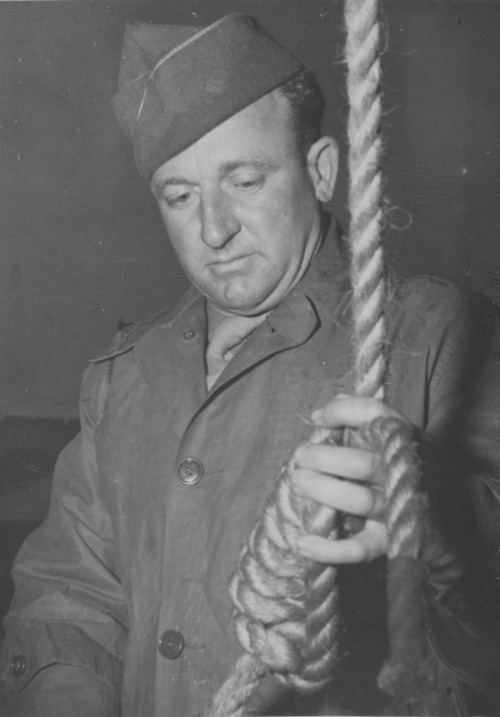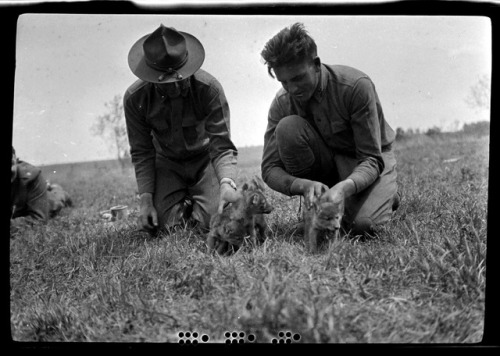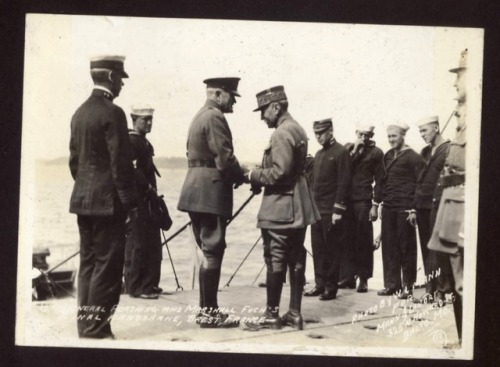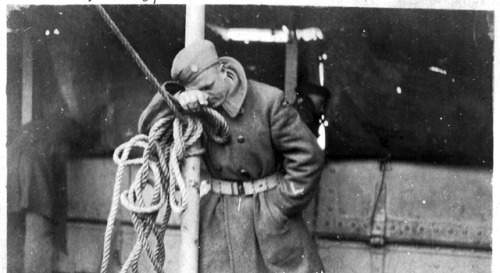#us army
French troops on their way to the fighting lines in Tunisia shake hands with American soldiers at the rail station in Oran, Algeria, North Africa, on December 2, 1942. (AP Photo) [x]
Post link
Holding the high ground.
U.S. Army Sergeant Curtis Smith, left, provides security during an Afghan Border Patrol outpost assessment at the Nawa Pass in Afghanistan’s Kunar province, Feb. 10, 2013. Smith is assigned to the 101st Airborne Division’s Security Force Advise and Assist Team Gambit, 2nd Battalion, 327th Infantry Regiment, 1st Brigade Combat Team.
Post link
Mondays are Lolligag Formation days.
U.S. Army Lt. Col. Delbert Hicks, commander of the Special Troops Battalion, 173rd Airborne Brigade Combat Team, awards soldiers at an end of tour awards ceremony on Forward Operating Base Shank in Logar province, Afghanistan. The soldiers received awards for their exemplary services during a nine-month deployment to Afghanistan.
(Photo by Spc. Alexandra Campo, 19 FEB 2013.)
Post link
Insomniac #soldierporn: Nocturnal predators venture forth.
Soldiers with 2nd Brigade Combat Team, 4th Infantry Division, walk into the sunset to catch their flight out of Forward Operating Base Pacemaker. The soldiers were on a mission to deliver holiday gifts of cookies, candy and personal hygiene products to the outlying FOB. A Chinook helicopter flew in to pick the soldiers up; the resulting brownout caused the foggy look of the photograph.
(Photo by Sergeant Ruth Pagan 25 DEC 2011.)
Post link
Evening Quickie #soldierporn: Let’s do innuendo.
The sun rises behind “spur holders,” from 1st Squadron, 10th Cavalry Regiment, 2nd Brigade Combat Team, 4th Infantry Division, while they wait for candidates during the squadron’s annual spur ride. The “Warhorse Spur Ride” is a 36-hour event designed to push soldiers to their physical and mental limitations by testing their ability to operate as part of a team under high levels of stress and fatigue under both day and night conditions.
(Photo by Staff Sgt. Ruth Pagan, 2nd BCT PAO, 4th Inf. Div, 1 NOV 2012.)
Post link
DUSTOFF dry run.
Tech. Sgt. Christopher Hibben, Combat Aerial Photojournalist, 4th Combat Camera Squadron, March Air Reserve Base, Calif., documents simulated patients being transported for care by a U.S. Army HH-60L Black Hawk medevac helicopter at the Joint Readiness Training Center, Fort Polk, Louisiana. Service members at JRTC 13-04 are educated in combat patient care and aeromedical evacuation in a simulated combat environment.
(Photo by Tech. Sgt. John R. Nimmo, Sr, 20 FEB 2013.)
Post link
Happy Flag Day and 239th birthday to the United States Army!
Show your patriotism by making a contribution to our cause:
https://www.indiegogo.com/projects/normandy-a-world-apart/
Post link
“An MP on motorcycle stands ready to answer all calls around his area. Columbus, Georgia,” 4/13/1942
Series: Photographs of American Military Activities, ca. 1918 - ca. 1981
Record Group 111: Records of the Office of the Chief Signal Officer, 1860 - 1985
Image description: A Black soldier sits on a motorcycle. He wears a service cap, holster, and tall boots with his uniform. A sign on the building behind him reads, “MILITARY POLICE / COLORED.”
Post link
War Department Pamphlet, Army Talk, Number 170 [cover and page 24], 4/12/1947
This pamphlet discusses the Army’s position on Black soldiers; answers from surveys about Black soldiers; and discussion of other minorities.
File Unit: Segregation in Armed Forces [1947-49], 1946 - 1953
Transcription:
WAR DEPARTMENT, WASHINGTON 25 D. C.
12 APRIL 1947
ARMY TALK
[handwritten note p29]
[illustration of Black troops performing mechanical work]
170
Note to Discussion Leader:
This ARMY TALK consists of three parts:
Part I - Negro Manpower in the Army
Part II - Negro Platoons in Composite Rifle Companies - World War II Style
Part III - What About Minorities?
This Talk is designed for discussion on three separate days as directed in section
V, WD Circular 76, 1947.
Before conducting the series, the discussion leader should read carefully section
V, WD Circular 76, 1947 and WD Circular 124, 1946, which are reprinted on the
last pages of this Talk. Circular 124, 1946, gives the general provisions of a revised
Army policy about the use, training, organization, and assignment of Negro personnel,
together with a reprint of the approved Gillem Board Report upon which
the revised policy is based.
In Part I of the Talk stress should be laid upon the threefold objective of the
policy:
1. An immediate objective - a more varied use of the Army’s Negro manpower
than has been peacetime practice hitherto.
2. An ultimate objective - the effective use of all available manpower, should
war come again, without regard to antecedent or race.
3. An over-all objective - increasing the effectiveness of the Army.
In all the Talks it should be borne in mind that the discussion of “race” is likely to
touch off sparks from individuals who have deep-seated beliefs, convictions, or
prejudices in one direction or another. Such discussions, however, may be handled
constructively if the group is kept aware that while differences in personal opinion
are to be expected and respected, the basic purpose of the Troop Information
Program is to bring information to troops and to develop understanding through
discussion.
These Talks, then, should inform troops about War Department policy and stimulate
discussion.
Part One
NEGRO MANPOWER IN THE ARMY
How to use its manpower best is always one of the Army’s problems.
How to use its Negro manpower best is in some respects a special
problem. It is of significance to the entire Army. To this special
problem several factors contribute:
(1) The “general run” of Negro soldiers have had considerably less
civilian schooling than the “general run” of white troops; they are
much less likely to have had civilian training and experience in highly
skilled mechanical fields; they make much lower scores on the Army
General Classification Test.
[sidebar] The most effective use of its
Negro personnel is of concern
to the Army.
WD Circular 124, 1946, and section V, WD Circular 76, 1947, appear on the last pages of this TALK
[page 2]
How did the Axis method work? It was simple. Get your victim to squabble with his friends instead of with his enemies. Play on his fears and resentments to make him hate groups of his own people. Start him quarreling at home. Break down his unity and strength. Thus you’ll weaken him so much that you can destroy him easily. It’s just an application of the old story of the bundle of twigs: when tied together they can’t be broken, but separately they are easy. United, they win; divided, they fall.
It’s no secret now that Hitler hoped to crack the United States wide open by driving wedges between the many groups on our population as he had done in some of the countries of Europe. It’s no secret that Japan tried to make the war in the Pacific a race war, with every person whose skin was “darker” united in a holy war against every person whose skin was white. That neither of these attempts got to first base in the United States or in our fighting forces means that in a time of national crisis the ideas that held us together as a nation were stronger than the differences that might have divided us.
Even at that, although , a public opinion poll made at the height of the war revealed that 85 percent of our population accused one or more of the following American groups of profiting selfishly from the war:
Farmers
Negroes
Jews
Foreigners
Protestants
Catholics
Business Men
Labor Leaders
Working People
That’s a pretty big list, isn’t it? How many Americans can you think of who don’t fall into one of those groups?
[sidebar] But the dangers of serious group antagonism are always with us.
And now that the fighting is over, now that we are trying to get back to peacetime status, and especially when the almost sure-to-come economic troubles begin to show up, the tendency to break up into groups, to point fingers, and to build up resentment against minorities can set in strongly without any pressure from the outside. We do not wish to use the Axis method on ourselves.
STOP How do scientists describe attitudes toward minorities?
[sidebar] A scientific view of group attitudes:
Not long ago a number of scientists at an American university, studying the matter of group attitudes, developed a chart they called “A Continuum of Relationships Among Human Groups." [superscript 1] For "Continuum” in this discussion we can substitute the word “scale.”
This scale or chart of how groups feel and act toward each other ranged all the way from persecution at the bottom of the scale to cooperation at the top. And on the way up it listed such attitudes and acts as discrimination, prejudice, preference, tolerance, and respect, in that order.
———————
[superscript 1] From The ABC’s of Scapegoating, published by the Central YMCA College, Chicago 6, Ill.
24
Post link
“C Btry fired last American heavy artillery round in Vietnam,” 4/9/1972.
Series: Artillery Unit Records, ca. 1965 - ca. 1972
Record Group 472: Records of the U.S. Forces in Southeast Asia, 1950 - 1976
Transcription:
CONFIDENTIAL
DAILY STAFF JOURNAL OR DUTY OFFICER’S LOG
For use of this form, see AR 220-15; the proponent agency is
Office of Deputy Chief of Staff for Military Operations.
PAGE NO. 1
NO. OF PAGES 1
ORGANIZATION OR INSTALLATION
Hq 2d Bn 94th FA
LOCATION
AT989714
Hill 34, RVN
PERIOD COVERED
FROM HOUR 001 DATE 9 Apr 72
To HOUR 2400 DATE 9 Apr 72
ITEM NO. TIME INCIDENTS, MESSAGES, ORDERS, ETC. ACTION TAKEN INI-TIALS
IN OUT
1 0001 (U) Journal Opened.
2 1400 © C Btry fired last American heavy
artillery round in Vietnam. DSJ
3 SUMMARY: The last firing unit wi th a
tactical mission was released from it.
C Btry fired the last heavy artillery
round for American Artillery. C Btry
began standdown.
4 2400 (U) Journal Closed.
CONFIDENTIAL
DOWNGRADED AT 3 YEAR INTERVALS; DECLASSIFIED AFTER 12 YEARS, DOD DIR 5200.10
TYPED NAME AND GRADE OF OFFICER OR OFFICIAL ON DUTY
DERAL E. WILLIS, MAJ, S-3
SIGNATURE
[handwritten signature : Deral E Willis]
DA FORM 1594 1 NOV 62
PREVIOUS EDITION OF THIS FORM IS OBSOLETE
U.S. GOVERNMENT PRINTING OFFICE [illegible]
Post link
Tired and covered with dust, three of the five members of an M-4 Sherman tank crew stand in front of their vehicle after field exercises and formation drills at Fort Knox; Kentucky - 1942
Post link
Chaplain Paul J. Maddox conducting Easter sunrise services for men of IV Corps. In front is Major General Willis D. Crittenberger, C.G., IV Corps. Fifth Army. Castelluccia, Italy. 1 April 1945.
(Photo by McWhirter. 196th Signal Photo Co. U.S. Army Signal Corp photograph, Gift in Memory of William F. Caddell, Sr., from the collection of The National World War II Museum)
Post link
“They did not cheer at the sight of their native shores”
“The return voyage was lacking the excitement and adventure of the trip to France, more than two years before. Those veterans who were fortunate enough to come back had developed character and seriousness: to them, life could never again be the same. In the lines of their faces was written the inflexible resolution that had swept them over the enemy’s strongest resistance, and in their steady eyes was the look that had calmly faced death in every form. Their early excitement had given place to sober contemplation, and they did not cheer at the sight of their native shores.”
“September 5 1919, part of the famous 1st Division arrives home, in Hoboken, New Jersey, see photo –History of the First Division During the World War, 1917-1919 –Photos:September 1919, “1st Division at Sea”. The close-ups show these soldiers’ stern and weary faces – National Archives
Note: The First Infantry Division also known as the “Fighting First” earned the distinction of being:The First permanent division in the regular Army – The First American division to land in France – The First American division in the trenches – The First American division to fight in WW1 and suffer combat casualties – The First to use modern, combined arms operations – The First to defeat the enemy at the Battle of Cantigny.
Post link
“Handsome little fellows”
“I know foxes get lots of the farmers chickens, and many partridges, and pheasants, but they pay for what they get by their destruction of mice and other things, and anyway they are too smart to destroy.
The babies make the cutest little pets…They are handsome little fellows and have the softest fur running thru every change of gold and yellow brown, with white throats, they are an entrancing sight.”
Farm Boys And Girls Leader (postwar magazine) – Photo: 1918/1919, France, American soldiers playing with “baby foxes” – Missouri Over There
Post link
“Let’s drop the Hero Stuff”
‘Home isn’t so far away now. We can measure, almost in days, the time remaining ahead of us in France. As we sit in our sanctum, penning these words, we can smell the sea; Ahead of us, three thousand miles away, is Hoboken. But – There’ll be jobs to look for when we get back. We must continue to eat and dress and live in civil life and we won’t have any Uncle Sam handing us three meals a day. Yes, there’ll be work to look for.
And we’ll have to come down to earth, too, in looking for jobs. For a time, we’ll have lot of fun playing the Returning Hero and Prodigal Son stuff. But, that will end. There’ll come a time when we’ll discover that a man may be a Perfect Hero and a Bum Mechanic; an Ideal Over the Topper but a Poor Sign Painter; a Dashing Machine Gun Nemesis and a Darned Poor Clerk.
We’ll have to offer the employers more than a War Record. We’ll have to Deliver the Goods. So let’s drop the Hero Stuff before the folks at home get tired of us, before the employers get the idea we’re asking for jobs solely or the strength of the fact we came over.
There are a lot of efficient men in our line of work who didn’t come over. This hurts us. But, it’s the truth. Think it over.’
1919, American soldiers in France – The Lorraine Cross, published by the 79thDivision – Photo: 1919, front of the City Hall of Trenton, New Jersey, a group of citizens welcoming the returning soldiers – Library of Congress
Post link
“Godspeed Mon Ami”
‘September 1st1919– Arrived in Brest this morning on scheduled time at the station. I was greeted by Marshal Foch who had come down to Brest the night before to say goodbye. The marshal made a very nice address complimenting me upon the way I handled the task before me during those past two years. In my reply, I emphasized the honor I felt in having him personally come to bid me Godspeed. I also touched upon the cordial relations between France and the United States and expressed a sincere hope for the continuance of this friendship.
At 3 o’clock the Leviathan began its homeward journey. There were a number of small French destroyers with bands aboard which came out alongside and circled about us as we left. I was very touched when I noticed that the marshal had boarded a small French ship and had come alongside just as we were leaving to wave goodbye again.
As we were leaving the harbor of Brest I went up on the Captain’s bridge where I could better wave to the people who had come out to say good-bye this last time.’
AmericanGeneral Pershing bidding farewell to France – John J. Pershing Diary. July 31,1919-July 11,1920 – more about this historic farewell “Marshal Foch Bids General Pershing an Affectionate Farewell”—Photo:September 1st1919, Brest, The Final Handshake – SCU Digital Collections – Also, YouTube “Pershing’s Farewell to France”
Note: Although Pershing embarked for home on September 1st 1919, American troops remained in France through the end of the year. And according to the terms of the Armistice, American soldiers occupied a zone in the Rhineland until 1923.
Post link
“I’m coming home”
“Sweet mamma I have did my bit now I am coming home – be good until I get there have plenty to drink at the house I mean whiskey – hello sister brother is on his way at last an we will have some fun – it taken me 11 days to make the trip goodbye from your son Ramsey.”
1919, France, African American soldier, Ramsey Adkins, 370th Infantry, writing a beautiful note home, as he embarks on his journey home – When Johnny Comes Marching Home – Photo: American soldiers and sailors sailing from Brest to NYC – U.S. Navy’s Naval History and Heritage Command
Post link
“The view of the mouth of the Hudson River and the Statue of Liberty strikes something in all of us. … As the steam whistles blast out a chorus and Manhattan comes into view, one can almost feel the beat of the city—and New York was certainly beating in August 1919.”
Doctor to the Resistance: The Heroic True Story of an American Surgeon and His Family in Occupied Paris – Photo: 1919, New York! Missouri Over There
Post link
“Just seasick, that’s all”
‘Thursday August 28, 1919 – Nothing but more storms last night – sea sickness – now feeling good’
Diary of American soldier Sgt. O'Neill, 35th Div, sailing home from Brest to New York (reached NYC Aug 30) – Photo: Just seasick, that’s all – Text and photo: National WWI Museum and Memorial
Post link











![War Department Pamphlet, Army Talk, Number 170 [cover and page 24], 4/12/1947This pamphlet discusses War Department Pamphlet, Army Talk, Number 170 [cover and page 24], 4/12/1947This pamphlet discusses](https://64.media.tumblr.com/a008781338adc9cdedd215ae00881eea/d166b24b0c160c9c-de/s500x750/03bff5cbf3522f7b7a67eb2374cf488d2118955b.png)
![War Department Pamphlet, Army Talk, Number 170 [cover and page 24], 4/12/1947This pamphlet discusses War Department Pamphlet, Army Talk, Number 170 [cover and page 24], 4/12/1947This pamphlet discusses](https://64.media.tumblr.com/ed92bfa5cd526e6240e8f722bcccbc45/d166b24b0c160c9c-02/s500x750/b39d14f69dccfef37e414189a5041215c189292d.png)











